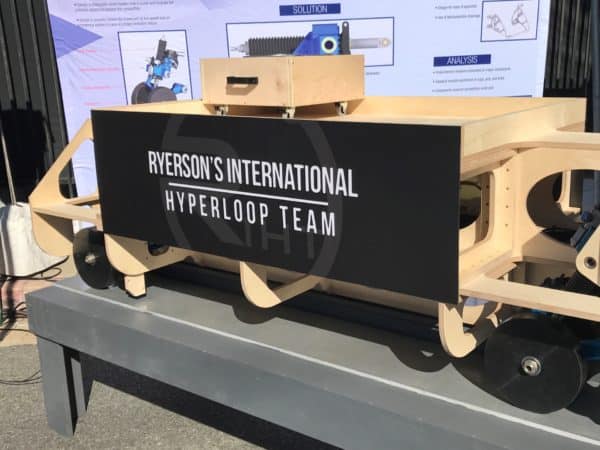
 Canadians are making an impact on the race to build the world’s first hyperloop system, a concept design promoted as the future of transportation.
Canadians are making an impact on the race to build the world’s first hyperloop system, a concept design promoted as the future of transportation.
The last weekend in January saw university teams from across North America and around the world competing in SpaceX’s hyperloop pod competition in Hawthorne, California, with a small but significant Canadian component.
After making the semi-final cut, the 150-person Waterloop team from the University of Waterloo brought their prototype pod down to California to compete against 30 other teams at the SpaceX test track, a mile-long, scaled down version of the vacuum tubed transit concept outside of SpaceX and Tesla’s Design Studio in Hawthorne.
Ryerson University’s hyperloop team has also made waves over the past year with its hyperloop pod retractable wheel design which won the top performer award at last year’s leg of the competition in the subsystem innovation category.
“It feels like you were in 1910 when the Wright brothers were flying the first aircraft. I had that feeling about the project,” says engineering professor Seyed Hashemi about his team of students. “We know it’s going to go somewhere, we don’t know how fast it’s going to reach its goal.”
Hyperloop is a high-speed transportation dream spurred on by visionary and Tesla founder Elon Musk, whose SpaceX aerospace company has been backing research on the project over the past few years. The aim is to produce a pneumatic tube-like form of travel, with people and goods loaded into pods that travel along in near-airless vacuum (and thus friction-free) tubes at supersonic speeds. SpaceX projects its planned pod system will be able to take people from San Francisco to Los Angeles in 30 minutes, and to spur interest and creativity, the company opened up a competition challenging teams of university students to come up with their best designs.
The only full Canadian entry in the race, the University of Waterloo’s Waterloop pod, named Goose I, is a functional, half-scale prototype reported to travel up to 550 kilometres per hour. Technical team lead Yazan Obeidi sees the competition as a launching pad for innovation and student interest in design at Waterloo, saying that the January test is “just the start of a new era for Waterloop.”
“That’s the great thing about being on a student design team. It’s not just about solving equations,” said Obeidi. “You go out and lay down 300 feet of track and find out what happens when you are only slightly off center. You have to tear it down and build it again.”
The Ryerson International Hyperloop Team (RIHT) saw its wheel design used on several prototypes showcased by other schools at Hawthorne and has plans to either build its own pod for next year’s SpaceX competition round or team up with another group. Reportedly the smallest group to attend the Hawthorne competition, RIHT tested their wheel system beforehand at aircraft landing gear company Safran Landing Systems in Ajax where the retractable wheel system successfully deployed at the speed of 354 km/h.
The January competition finished with the fastest pod award going to the WARR Hyperloop team from the Technical University of Munich and the highest overall score won by Delft Hyperloop from Delft University of Technology in the Netherlands.
Leave a Reply
You must be logged in to post a comment.




 Share
Share Tweet
Tweet Share
Share




Comment